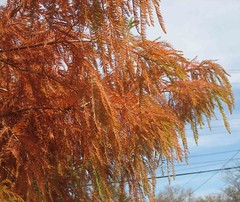My friend Miguel has posted some great snaps of my favorite bit of bike trail in the city, the shaded, secluded stretch of bosque trail south of the National Hispanic Cultural Center.
Remembering the Past
My Journal colleague Pat Vasquez-Cunningham did a beautiful multimedia package based on his photographs and interviews with Pearl Harbor survivor Ray Baker. Additional interviews with Homer Garcia, John Stanhope and James Rounding.
El Niño Update
The latest ENSO forecast is out this morning:
El Niño conditions are likely to continue through May 2007.
The models are clustering around a relatively modest affair.
A New Mexican Insurgency
My colleague Tania Soussan wrote Saturday about what Andrew Dessler has described as “the climate change insurgency“:
Cars with dramatically better gas mileage.
More energy-efficient houses and offices.
Doubling the renewable energy flowing through New Mexico’s grid.
Those are among the 69 recommendations announced Friday by a special climate advisory group created by Gov. Bill Richardson last year to find ways to cut greenhouse gas emissions.
If all of the ideas were put into practice, greenhouse gas emissions in the state would drop to pre-1990 levels by 2020— or half of what is projected if no changes are made— and the economy would get a $2 billion boost over the next decade.
“This is a really bold and exciting proposal that will help New Mexico do its share to reduce greenhouse gases,” said Jim Norton of the New Mexico Environment Department.
The Rising Cost of Bread in Australia
The cost of Australian bread is on the rise:
Bushman’s Bakery, which has six outlets in the Coffs Harbour area, has told customers the drought has pushed the price of a loaf of bread up by 20 cents.
Owner Dally Sullivan says there is no choice but to pass on the cost.
“We were notified a few weeks ago by our flour millers that there was going to be a very big price increase in the vicinity of $200 a tonne for flour because of the shortage of wheat due to the drought,” he said.
“That has forced us to increase the price of the bread, and a rise of $200 a tonne equates to something like 20 cents a loaf.”
Back in the day, people starved. In that context, 20 cents a day seems reasonable.
What Tree Is This?
Anyone have a clue what kind of tree this is? Photo by L. Heineman, fall 2006, on San Mateo NE in Albuquerque.
That Badass Paleo Record
More evidence of the naivety of assuming that the 20th century climate record is sufficient to capture the range of variability with which we’ve got to be able to cope. Tian et al in GRL looked at calcite layers in Minnesota lake sediments:
[D]roughts of greater severity and duration than during the 20th century occurred repeatedly, especially prior to 300 AD. Drought variability was anomalously low during the 20th century; ?90% of the variability values during the last 3100 years were greater than the 20th-century average.
Snow
The Horror
As if drought, famine, rising sea level inundating coastal cities and the cancellation of international ski competitions were not enough, my colleague Dan McKay in this morning’s paper catalogues a previously unmentioned and potentially devastating consequence of global warming: It could harm Albuquerque’s famed balloon fiesta, “the world’s most photographed annual event.”
Worrying about the balloon fiesta may sound silly, but City Attorney Bob White said Wednesday that the concern is real, and that global warming could affect the wind conditions that allow ballooning to flourish above Albuquerque.
“As we do damage to our rivers and airshed, the Rio Grande box is something that is very important” that could be harmed as well, White said.
The “box” refers to a pattern of winds that blow in different directions at different altitudes. A pilot can take off from the balloon fiesta field in one direction, rise to a higher altitude and fly back over the field.
Radioactive Laundry Lint
There’s a phrase that’s never appeared in the Googleverse. Until now.



